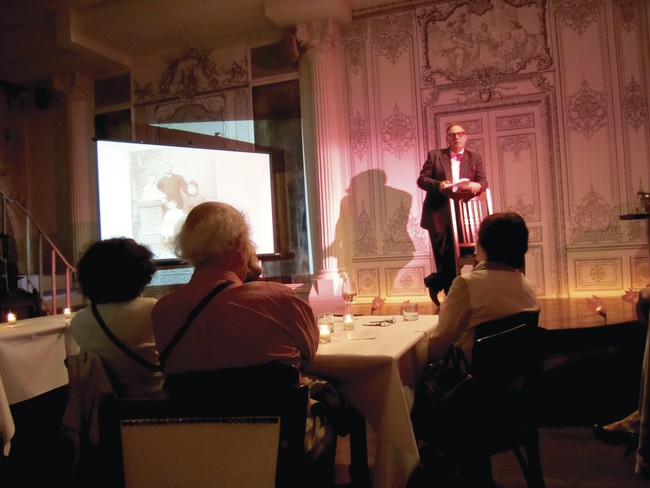
As the Museum of Modern Art plans to close the curtain on its blockbuster Le Corbusier exhibition, Le Corbusier: An Atlas of Modern Landscapes, three miles downtown a considerably more risqué side of the Swiss-French architectural master took the spotlight on Sunday. In a one-man, one-night show at Bowery Poetry Club, U.K.-based Charles Knevitt, former architecture critic of The Times in London, staged his play Le Corbusier’s Women, a monologue in which the architect discloses a sexual appetite as intrepid as his plans to raze Paris.
Bespectacled and bathed in pink light on a small stage, Knevitt-turned-Corbu was frank with the audience, “You have come here to hear about my dirty side.”
The reading, a performance-lecture hybrid accompanied by a PowerPoint-style slideshow, began with Le Corbusier’s humdrum upbringing as Charles-Édouard Jeanneret in La Chaux-de-Fonds, Switzerland. But after catching the audience up to speed, the script—based on items found in Le Corbusier’s 450,000-strong archive—delved into the man behind the cast-in-place concrete: a married man with a serious Oedipus complex and an insatiable id. The architect allegedly had a staggering number of “amorous bouts,” managing to woo (to name a few) performer Josephine Baker, sculptor Mitzi Solomon, Sri Lankan architect Minette de Silva, and British showgirl Christine Keeler.
“How do I like my women?” the performer-as-architect asked, “Fat, plump—Rubenesque!” And, like some gentlemen, he preferred blondes—Le Corbusier’s Women alludes to a tryst with Marilyn Monroe (then Mrs. Arthur Miller) on the beaches of Long Island; she 32, he 71. (The rumor has it that he drew her a new beach house in the sand.) “Too good to be true?” Le Corbusier—a self-described gigolo—asked the audience, “You must decide for yourself.”
Knevitt churned through the 7,000-word script (with plenty of water breaks in between) in approximately one hour.
While equally informative and entertaining, Le Corbusier’s Women left something to be desired. Knevitt’s script repeatedly emphasized that Le Corbusier sought, above all (and perhaps futilely), tenderness in his many affairs. Yet it was difficult to empathize with the fictionalized architect; The Le Corbusier in this play wasn’t confessional, but nonchalant, boastful, and chauvinistic. The reading also could have delved deeper into how the women impacted his life and work, rather than a dirty laundry list of sexcapades.
But, as Knevitt explained after the performance, he wrote the play to question the architect’s saint-like status in the architecture world, and reveal a human side: “Strip away the mask and what do you see?” Le Corbusier says at the performance’s finale, dramatically removing his iconic, round black glasses, “A man in search of himself through others.”
In spite of the play’s somewhat naughty subject matter, Knevitt kept the play surprisingly tame. Reportedly, there is interest in turning the reading into a full-blown musical. (Knevitt said he has not planned any further performances of the play in its current form.) But references to Le Corbusier’s libidinous tendencies continue to ruffle feathers, almost half a century later. Knevitt said the AIA New York chapter wouldn’t host the performance. Again, Knevitt says, it comes down to the deification of architectural greats. “It’s like saying the Queen Her Majesty uses the lavatory,” Knevitt said. “She doesn’t.”



Post a comment to this article
Report Abusive Comment